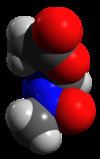 | ||
Medical vocabulary what does methylazoxymethanol acetate mean
Methylazoxymethanol acetate, MAM, is a neurotoxin which reduces DNA synthesis used in making animal models of neurological diseases including schizophrenia and epilepsy. MAM is found in cycad seeds, and causes zamia staggers. It selectively targets neuroblasts in the central nervous system. In rats, administration of MAM affects structures in the brain which are developing most quickly.
Contents
Schizophrenia
In rat models, the specific effect of MAM on neural development depends on the gestational age of the subject. At the seventeenth gestational day (GD17), administration of MAM produces behavioral and histopathological patterns found in schizophrenia. The molecular mechanism behind this model is not fully known. Methylazoxymethanol acetate administered at GD17 reduces the thickness of the hippocampus and the thalamus. The locomotor effects of amphetamines and the spontaneous firing rate of dopaminergic neurons in the ventral tegmental area are increased. In alternating maze tests, GD17 MAM rats quickly learned the first rule, but took longer to accommodate to alterations to the rule; this is thought to indicate deficits in working spatial memory, which is also impaired in schizophrenia.
Epilepsy
Exposure to MAM before birth increases susceptibility to epileptic seizures caused by flurothyl. Prenatal MAM exposure in rats results in a model of brain malformation. In some MAM animals, video-EEG monitoring has documented the presence of spontaneous electrographic seizure activity In some epilepsy rat models, MAM is administered at the fifteenth gestational day. Previous studies have found impaired cognitive function in GD15 MAM rats, and a reduced seizure threshold. At the cellular level, dysplastic hippocampal neurons in the MAM model were shown to have reduced potassium current function and expression for the Kv4.2 channel subunit These findings may contribute to the spontaneous seizures and reduced seizure thresholds seen in this model.
